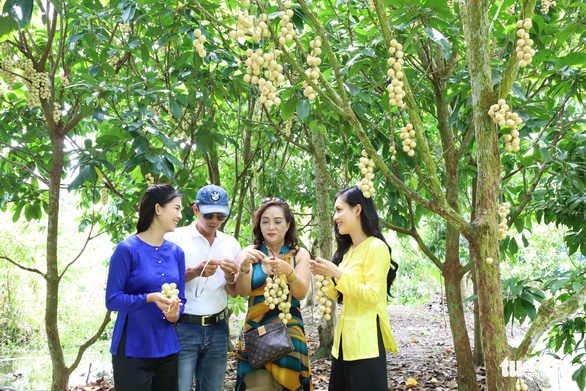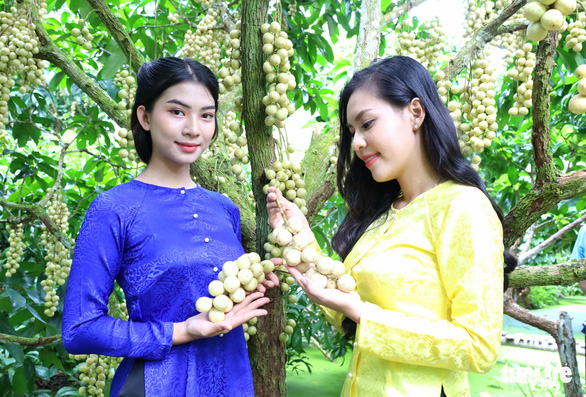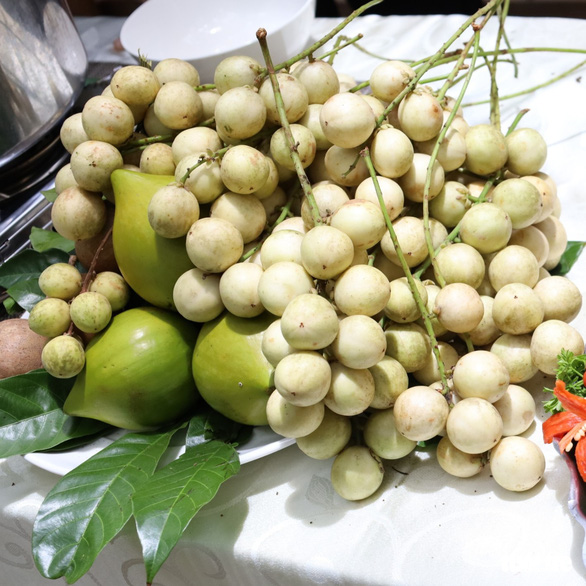Can Tho City in Vietnam’s Mekong Delta is known for its tropical fruit orchards, particularly its Ha Chau burmese grape garden. Yet despite the popularity of these gorgeous yellow grapes, few people are aware of the role they play in the mouth-watering local delicacy ga um dau Ha Chau.
Ha Chau burmese grapes are registered as a Phong Dien specialty trademark, with their primary growing areas located in Can Tho’s Phong Dien Town where a local resident discovered and genetically modified the unique fruit.
Ha Chau burmese grape gardens span approximately 800 hectares in the district and grow alongside other burmese grape species.
When ripe, the edible portion of the fruit has a lovely ivory-white tint and a sweet taste and fragrance.
 |
| Tourists visit a Ha Chau burmese garden in Phong Dien Ward, Can Tho City, Vietnam’s Mekong Delta. Photo: T.Luy / Tuoi Tre |
Ha Chau burmese grapes yield three annual harvest, with the largest during the fifth lunar month, followed by a second harvest in the seventh and eighth lunar month and a final harvest in during first lunar month of the next year.
A major reason Ha Chau burmese grapes are favored by locals is due to their use in ga um dau Ha Chau (braised chicken with Ha Chau burmese grape) – a local delicacy that visitors to Phong Dien District should be sure not to miss.
Locals say that ga um dau Ha Chau is best eaten between July and October, when the grapes are at their sweetest.
Other ingredients in the dish include chicken, cayenne pepper, coconut, and shallot.
 |
| Two women pose for a photo with a cluster of Ha Chau burmese grapes in Phong Dien District, Can Tho City. Photo: T.Luy / Tuoi Tre |
To cook this dish, locals begin by choosing a 1- to 1.2-kilogram Vietnamese yarding chicken for its naturally sweet and chewy flavor.
The chicken is then cut into small pieces and marinated with salt, sugar, broth, and cooking oil.
The burmese grapes are then peeled and caramelized with sugar, minced onion, minced shallot, and minced garlic.
After the chicken is marinated, garlic and shallots are fried until fragrant.
 |
| Clusters of ripe Ha Chau burmese grapes at a garden in Can Tho City. Photo: T.Luy / Tuoi Tre |
Next, coconut water is added to the pot and the chicken is cooked for 30 minutes before simmering with whole shallots and Ha Chau burmese grapes for another 30 minutes.
White wine is often added just before the dish is finished.
When trying ga um dau Ha Chau, diners can taste the chicken's natural sweetness and fatty flavor, as well as the fresh sweet and sour sauce made from the burmese grapes and coconut water.
Fish sauce mixed with cayenne pepper is an ideal dipping sauce for the dish.
 |
| A woman poses with a dish of ‘ga um dau Ha Chau’ at an orchard in Phong Dien District, Can Tho City. Photo: T.Luy / Tuoi Tre |
Like us on Facebook or follow us on Twitter to get the latest news about Vietnam!























